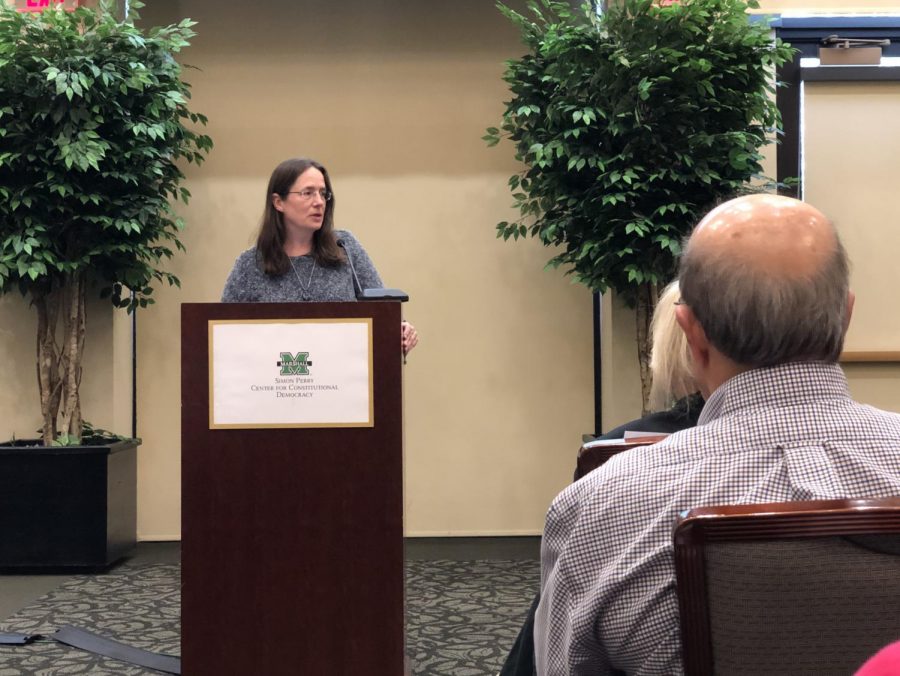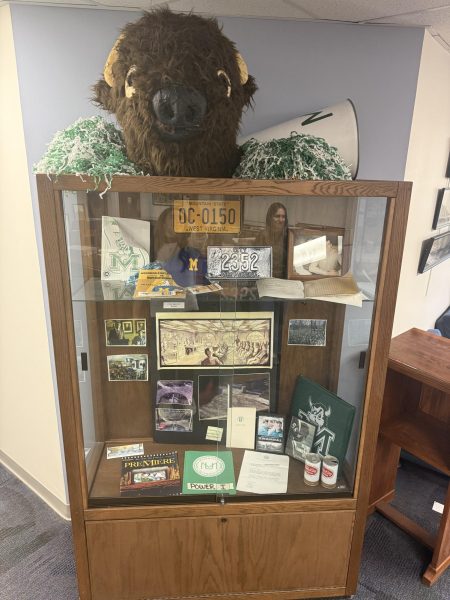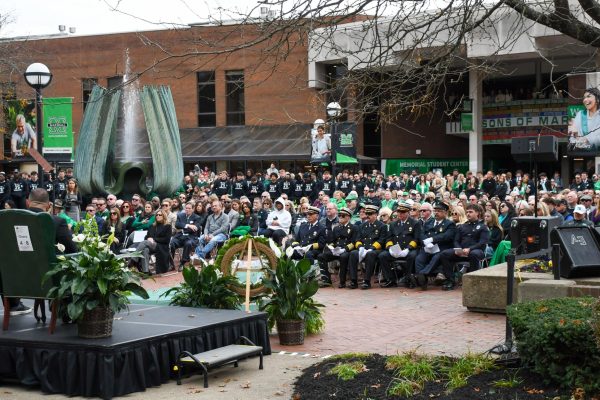Visiting history professor discusses ideologies of South, West
Heather Cox Richardson, a professor of history at Boston College and author, speaks about the ideologies of the South and the West, during an lecture in the Amicus Curiae Lecture Series on Constitutional Democracy Thursday in the Brad D. Smith Foundation Hall.
Ideology behind the Confederacy did not end after the Civil War, but lived on in the land of the West, a Boston College professor said Thursday in Marshall University’s Brad D. Smith Foundation Hall.
“What I want to outline today is the idea that the Confederacy was an attempt to overhaul democracy with an oligarchy, and the ideology that a few people should rule over the majority of everybody else is one that did not die,” said Heather Cox Richardson, a history professor at Boston College and national commentator on American political history and the Republican Party.
When President Abraham Lincoln gave his Gettysburg Address in 1863, he was not just dedicating a cemetery, Richardson said. He was rededicating America to “reinvesting in American freedom” and setting up a concept of democracy against a concept southern elite democratic slaveholders held in the latter part of the 1850s that led to the Civil War— a concept that all men were not created equal and certain individuals, who were the “superstructure” of society, needed to direct others.
“This is the idea that the vast majority of people really should not have a say in their society, either in the way they use their labor, but also they certainly should not be able to vote, because if they can vote, they’re going to want some of that capital that they’re producing, and they’re going to take that,” Richardson said. “And this is not simply a greedy ideology, it’s an ideology that says if they take it back they’re going to slow down the accumulation of wealth at the top, and we’re never going to be able to do things like have great museums and great universities and to be able to move the world forward, to move civilization forward.”
During the Civil War, the Republican Party, having a contrasting ideology to the slaveholders, tied the government to ordinary Americans through projects and legislation and had the government create opportunity for “all men at the bottom of society” including African Americans, shaping the government so that it was “completely revolutionized” by 1865, Richardson said.
When Republicans tried to defend the rights of African Americans in the South after the Civil War, however, President Andrew Johnson, who took over after Lincoln’s assassination, did something “crucial to American history,” Richardson said.
Richardson said what Johnson did was say the laws that were promoting the welfare of African Americans gave black people rights white people did not have and took white tax dollars and gave them to “undeserving,” or “lazy,” African Americans.
Johnson said the Republican program was a “deliberate attempt to redistribute wealth from white people to black people,” Richardson said, which made some Easterners in 1871 see using government “in a democratic fashion,” or in “Lincoln’s way,” as being socialism or communism.
In the West, which was already populated but not officially organized by the U.S. government, there was enslavement of Native Americans and lynching of Mexicans, and Westerners started to set up governments that recognized the “hierarchy” of different peoples within them, Richardson said.
The Civil War exacerbated racial hierarchies in the West, Richardson said, and after the war, some states in the West refused to ratify the 15th Amendment until they were sure it would not include Native Americans and Chinese individuals.
As the same time of this world that was “based in racial hierarchies,” the Reconstruction imageimage of the Western cowboy, which lasted from around 1866 to a “terrible winter” in 1886/87, was an image of a free man, Richardson said.
She said people thought that, in the West, everyone could be free, as opposed to in the East, where people believed there was “communism” and a government that took tax dollars and used them to support black people.
“The cowboy becomes this symbol of this individual who stands apart from the government, who’s really the only true American individual, and it takes on an enormous power because of the contrast with that corrupt, socialist, communist East,” Richardson said.
The image of the cowboy has been used during other parts of eras of American history as well, including when Westerns gained popularity in the mid-20th century and showed “an independent white man standing against the other, who is trying, in some corrupt way, to destroy that man’s independence,” Richardson said.
That image of the West and of an independent American who “stands against communism and stands against the redistribution of tax dollars from white people to black people” became a “driving force” of the Republican Party, Richardson said. The Western image was utilized by politicians Ronald Reagan and George W. Bush in the 20th century, she said.
Following the lecture, Patricia Proctor, director of the Simon Perry Center for Constitutional Democracy and the Amicus Curiae Lecture Series on Constitutional Democracy, said she originally invited Richardson to Marshall because she was interested in having her talk about Lincoln, but Richardson requested to talk about her new book, which shares the name “How the South Won the Civil War: The Significance of the West in American History” with the lecture and will probably be published in the next year.
Proctor said she thought having Richardson talk about her book would be “wonderful” and “interesting and different” and people could learn from it.
The next lecture in the Amicus Curiae Lecture Series on Constitutional Democracy is set for Thursday, April 25. The lecture, titled “The Problem of Democracy,” will be given by Nancy Isenberg and Andrew Burstein, two professors of history at Louisiana State University.
Jesten Richardson can be contacted at richardso164@marshall.edu.
Your donation will help continue the work of independent student journalism at Marshall University. If you benefit from The Parthenon's free content, please consider making a donation.







